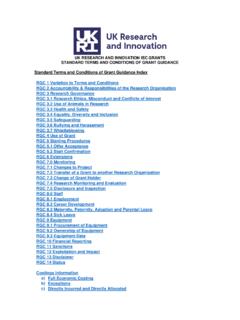Transcription of Innovation for Development - OECD
1 Innovation for Development A DISCUSSION OF THE ISSUES AND AN OVERVIEW OF WORK. OF THE OECD DIRECTORATE FOR SCIENCE, TECHNOLOGY AND INDUSTRY. May 2012. Innovation for Development A DISCUSSION OF THE ISSUES AND AN OVERVIEW OF WORK. OF THE OECD DIRECTORATE FOR SCIENCE, TECHNOLOGY AND INDUSTRY. May 2012. Organisation for Economic Co-operation and Development (OECD). The OECD is a unique forum where governments work together to address the economic, social and environmental challenges of globalisation. The OECD is also at the forefront of efforts to understand and to help governments respond to new developments and concerns, such as corporate governance, the information economy and the challenges of an ageing population.
2 The Organisation provides a setting where governments can compare policy experiences, seek answers to common problems, identify good practice and work to co-ordinate domestic and international policies. The OECD member countries are: Australia, Austria, Belgium, Canada, Chile, the Czech Republic, Denmark, Estonia, Finland, France, Germany, Greece, Hungary, Iceland, Ireland, Israel, Italy, Japan, Korea, Luxembourg, Mexico, the Netherlands, New Zealand, Norway, Poland, Portugal, the Slovak Republic, Slovenia, Spain, Sweden, Switzerland, Turkey, the United Kingdom and the United States. The European Union takes part in the work of the OECD.
3 OECD Directorate for Science, Technology and Industry (DSTI). The Directorate for Science, Technology and Industry leads the OECD's work on knowledge-based sources of economic and social growth and, more specifically, on the translation of science, technology and knowledge into Innovation . Contact us For further information about our work on Innovation for Development or to send us comments please write to: OECD 2012. Cover photo: Christopher Meder About this booklet This booklet discusses the relevance of Innovation for Development and several of the challenges that result for developing and emerging economies. It also provides an overview of work conducted at the OECD Directorate of Science, Technology and Industry, notably including ongoing activities in support of the OECD Strategy on Development .
4 It also provides an overview of work related to statistics and the availability of OECD databases on Innovation that cover developing and emerging economies. Contents Innovation matters for Development 4. Main topics of work on Innovation for Development 9. 1. The contribution of Innovation to economic growth and well-being 10. 2. The impact of globalisation on Development and Innovation 13. 3. Inclusive Innovation 16. 4. Education, skills and human capital 18. 5. ICTs for Development 20. 6. Institutional frameworks for Innovation policy 22. OECD statistics on science, technology and Innovation 25. Databases on Innovation and their coverage of developing and emerging economies 27.
5 3. Innovation matters for Development Innovation can make a difference in addressing urgent developmental chal- lenges such as providing access to drinking water, eradicating neglected diseases or reducing hunger. The transfer and, when necessary, adaptation of technolo- gies developed in developed countries can often contribute significantly to these goals. Substantial research efforts are needed to find solutions that address other global challenges. effective international co-operation that involves both public and private bodies is an important mechanism for finding these much- needed solutions. Moreover, one of the important lessons of the past two decades has been the pivotal role of Innovation in economic Development .
6 The build-up of Innovation capacities has played a central role in the growth dynamics of successful developing countries. These countries have recognised that Innovation is not just about high-technology products and that Innovation capacity has to be built early in the develop- ment process in order to possess the learning capacities that will allow catch up to happen. They also need Innovation capacity and local innovations to address chal- lenges specific to their local con- texts ( tropical diseases). Ulti- mately a successful Development strategy has to build extensive Innovation capacities to foster growth. While Innovation is important at all stages of Development , different types of Innovation play different roles at various stages.
7 In earlier stages, incremental Innovation is often associated with the adoption of foreign technology, and social Innovation can improve the effectiveness of business and public services. High-technology R&D-based Innovation matters at later stages of Development , when it is both a factor of competitiveness and of learning (which allows for completing the catch-up process). The following table provides a schematic overview of various aspects of Innovation for various categories of countries. Depending on the support mechanisms used, the types of Innovation and the main agents involved differ somewhat. 4. Why Innovation is important for developing and emerging countries Country Type/source of Innovation and main Mechanism/objective of Innovation category agents involved Developing/low- Adoption requires adaptation: Innovation Incremental Innovation based on foreign income countries needs to respond to specific local innovations and technologies and emerging conditions for outcomes and middle- Agents: universities and research institutes, income countries Examples: New plant varieties for agri- leading private businesses, esp.
8 Those with culture, efforts at developing new methods exposure to foreign markets and for mineral extraction in the Chilean copper businesses industry to satisfy local needs Inclusive Innovation : for/by low- and middle- Incremental Innovation based on foreign income households to improve welfare and technology and/or local, traditional access to business opportunities knowledge generated out of necessity . Examples: India (nano cars; grassroots Social Innovation helping to introduce Innovation ), mobile banking services. technical innovations in communities Agents: NGOs, small firms, public and private associations engaged in disseminating knowledge via networks, private, often large businesses Mainly middle- Build up Innovation capacities that will be Incremental and radical Innovation capacity income countries key for reaching the world technological to compete with leading world innovators but also some frontier in many industries, esp.
9 Relevant to opportunities for Agents: Requires full Development of avoid middle-income traps Innovation systems involving diasporas as developing /low- income countries Example: Korea increased R&D efforts in a connector the 1990s Address environmental, health and social Major innovations and scientific research challenges through global Innovation efforts conducted in global partnerships but also and local efforts to address them marginal innovations to address welfare of Example: Innovations concerning soil poor people Agents: Public and private universities and research institutions connected to global networks but also major private businesses operating in these sectors Build-up niche competencies growth/ Incremental innovations based on applying exports in sectors of comparative foreign innovations and technologies advantage strategically to support industrial Example: Colombian and Ecuadorian Development flower industry Agents: Public institutions to address co- Malaysia's palm oil sector ordination challenges, private sector initiative including foreign companies /.
10 5. Why Innovation is important for developing and emerging countries (cont'd). Country Type/source of Innovation and main Mechanism/objective of Innovation category agents involved Mainly emerging/ Climb the value ladder in global value Incremental and radical Innovation capacity middle-income chains to differentiate contributions countries after initial progress on Example: Automotive industry in Malaysia, Agents: Involves private sectors with India's software industry support from public agents, intermediaries, dimensions diasporas can play a central role, large above firms can be important Keep competitiveness in frontier industries Innovation is identical to developed when the country is already at the frontier countries exposed to developments in the Example: Brazilian company Embraer as global market well as leading R&D firms from emerging Agents.



















